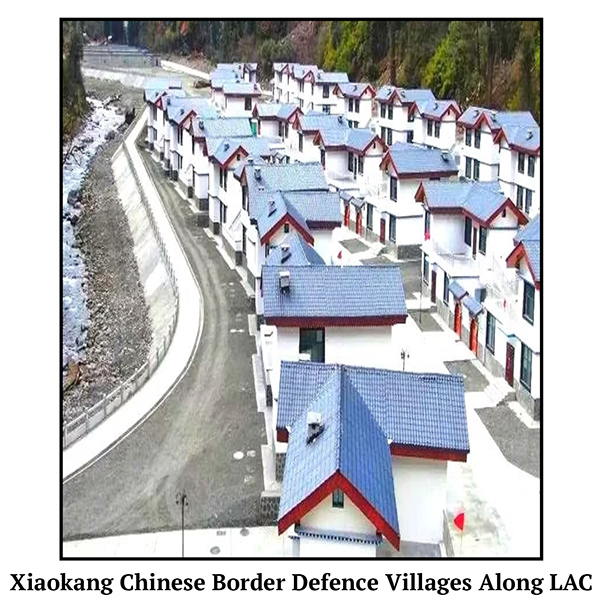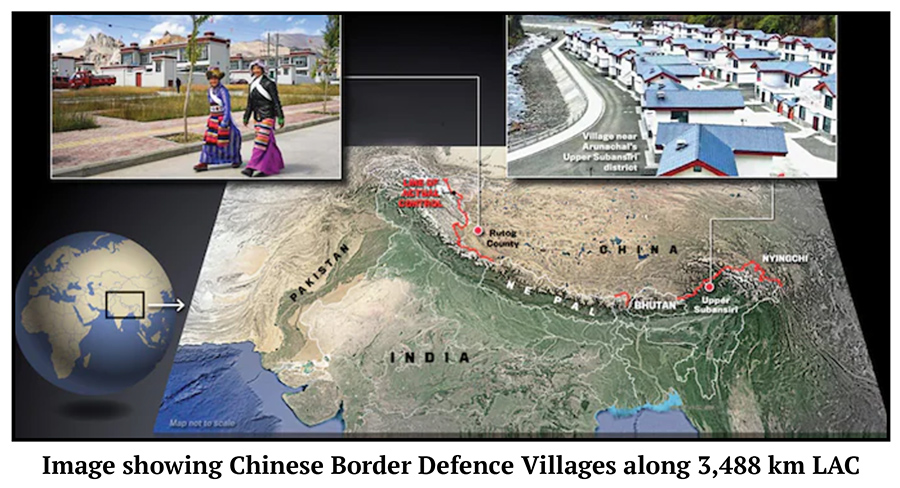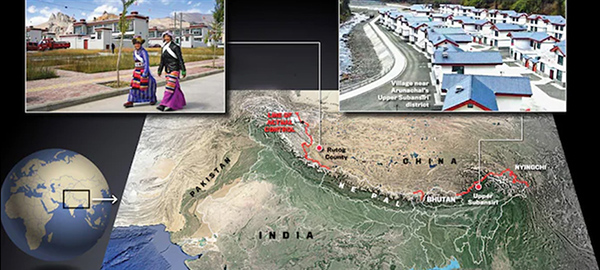

“China has been developing a series of model ‘Xiaokang’ border defence villages on its side of the LAC since the last two years to assert its territorial claims at the disputed borders with India.”

Xi Jing Ping have been pushing the Mao’s idea and strategy of Liberating the Five Fingers of the Tibetan Palm – Ladakh, Nepal, Sikkim, Bhutan and the North-East Frontier Agency (NEFA), present-day Arunachal Pradesh. This was a strategy espoused by Mao Tse Tung and used by the officials in the 1950s considers Xizang (Tibet) as the right palm of the Chinese state.
The concept of ‘Poverty Alleviation Villages’ was reintroduced in the political discourse of China in the 1970s but was not fully implemented as China was giving more emphasis to its urban development based on cities.
Describing it as a vanguard for the national security barrier, Xi Jing Ping after his first term pushed this strategy in modified form in a big way. As part of this strategy, China is developing a Xiaokang, a well-off border defence villages and these have mushroomed recently along the 3,488 km Line of Actual Cotrol, LAC.
Chinese Strategy and Aim Behind Xiaokang
The location of these villages along the contested territories in disputed and sensitive areas between India and China sheds light on the China’s real motives behind this move.
Earlier, China has used civilian militia consisting of Han Chinese in Tibet and Xingjian province to consolidate its claims over these areas and for military purpose.
Through the lines of these villages China aims to create a great wall between Tibet and the rest of the world. It also aims at changing the demographic identity of the region, with plans to enforce ethnic inter-mingling as a means to exercise control over the masses along the borders.
China may be trying to strengthen its territorial claims in anticipation of a resumption of negotiation in future. It seems to take advantage of the ‘Agreement on Political Parameters’ and ‘Guiding Principles for Settlement of the Boundary Question’, which India and China had signed in 2005. The Article VII of the 2005 agreement states that the two sides shall safeguard the interests of settled populations in the border areas while clinching a deal to resolve the boundary dispute.
China’s new ‘Land Border Law’ was enacted in 2022, also emphasises on the development of villages and towns in the border areas and the role of civilians in protecting sovereignty and territorial integrity. Thus, it is clearly indicating its plan to expand settlements along its disputed boundaries with India and Bhutan.
It may be targeting the border population of India and attracting them towards much modernised and better life in Chinese villages, apart from keeping an eye on any incursions.
Every village would have a Chinese communist party official, who would be propagating communist agenda of Xi Jing Ping. There are concerns about these officials sinister design across LAC.
The Chinese are known to gain the territory without fighting and the development of border defence villages must be seen from this prism and as a forthcoming challenge.
Similar to its salami-slicing tactics, this also seems to be aimed at presenting India with a fait accompli on the border dispute. Asserting sovereignty over rivers by creating conditions for future water imperialism and war with lower riparian countries.
These villages should be viewed together with the construction of bridges and railway lines in the same regions and their potential in increasing China’s ability to reach Arunachal Pradesh and at appropriate time push its claim of over 90000 Sq Kms of this area.
Implementation of plan by China
The ‘Tibet Autonomous Region’ (TAR) has been placed at the forefront of this strategy. The government of the TAR in 2017 launched a plan to build 628 villages in 21 counties, stretching from the Ngari, Shigatse, Shinnan and Nyingchi prefectures.
Satellite images of US-based private imaging firm ‘Planet Labs’ showed a concrete village of 100-odd houses in rows of white and grey roofed structures.
According to a Pentagon report, The first sets of such 100 buildings cluster of modern village came up on the banks of river Tsari Chu in Upper Subansari in the Longzu near one of the disputed area of Arunachal Pradesh.
The second village cluster near the Shi-Yomi district of Arunachal Pradesh with satellite images showing a Chinese flag painted from the rooftop of one of the houses. Both modern village clusters are approximately 93 km apart.

Similarly, there are reports regarding, the construction of two such villages in the Churup area opposite Uttarakhand, located 11 km from the LAC. Another comprising 35-36 dwellings is under construction in Qangze, about 52 km from the LAC. Image showing Chinese Border Defence Villages along 3,488 km LAC There are also reports of the construction of a Chinese village 2.5 km inside Bhutanese territory in two clusters opposite Siliguri corridor.
India’s Concerns
Depopulation is a major cause of concern of India from the border villages along LAC. Demographic shift is taking place with people moving to the plains for better economic and professional opportunities.
Between 2011 and 2018, over 185 villages in three border districts of Uttarakhand were declared completely depopulated and are termed ghost villages. As per one report there are close to 3000 ghost villages which exist in border areas along LAC.
The deceitful nature of the PLA is well known and massive out migration along the LAC will be seen as an opportunity to seize the Indian territory by salami-slicing tactics.
Massive Indian Response: Vibrant Border Villages Programme
To counter the Chinese aggressive and sinister design along the Chinese border, India announced the Vibrant Village Programme (VPP) in the Union Budget 2022-23 and has planned to open these area for tourists.
It has rolled out the VVP to develop the sparsely populated habitats along the disputed India-China boundary to counter the Chinese ploy to expand and cite settled population to LAC specially in sensitive and disputed areas.
The VVP is aimed at making it easier for people to live in villages along the LAC and dissuading them from migrating to other places. The thinning population could prove to be a disadvantage for it in its boundary negotiation with Beijing.
The programme would focus on the construction of village infrastructure, housing, tourist centres, road connectivity, provisioning of decentralised renewable energy, direct-to-home access for national TV network-Doordarshan and educational channels as well as support for livelihood generation.
With a focus on the Cluster, Convergence and Community the development of model villages will provide comprehensive expansion to the border villages providing better roads, power, water supply, health, internet connectivity and education.
Three model villages in Arunachal Pradesh at Kaho, Kibithoo & Meshai are being developed as a pilot project close to its borders at a cost of Rs 30 crore. The same would be replicate all along the LAC.
There are plans to open some of these boarder villages along the border for tourists under this programme. Villages in Ladakh has been identified like in Changthang region which can be turned into dark sky destination that could attract astronomy enthusiasts.
India is also constructing roads, tunnels, caverns and underground ammunition stores along the LAC, specially in the eastern sector.
This includes construction of the strategic 2.5 Km Sela tunnel in Tawang at an altitude of 13,000 feet. Nine more tunnels are also under construction. Another 11 more tunnels have been planned in second phase.
A 2,000 km Arunachal frontier highway following the McMahon Line, the Mago-Thingbu-Vijaynagar border highway has also been planed to be constructed on war footings.
These measures are being implemented in war footing in all along LAC with major effort being given to Arunachal Pradesh to defeat the Chinese design. China after ‘Doklam Stand Off’, ‘Galwan Clash’ and Kailash Range surprise move by Indian Military has realised that any direct deployment of force along the border will lead to stiff resistance. Indian Military is a force to recon with in mountain warfare and under strong national leadership and resolve could create an adverse conditions for China along LAC which would be detrimental for its global ambitions.








